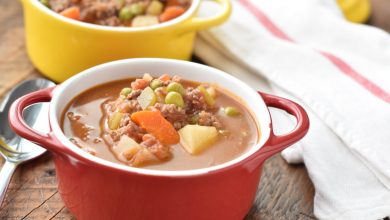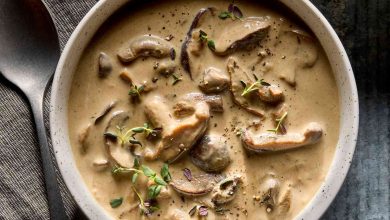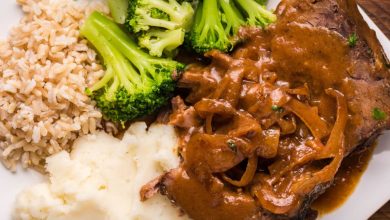Creamy Massachusetts Homemade Mayonnaise in 15 Minutes
Massachusetts Mayonnaise Recipe: A Culinary Classic
Overview
Welcome to the delightful world of homemade condiments with our Massachusetts Mayonnaise, a quick and easy recipe that transforms basic ingredients into a creamy, tangy, and versatile dressing. This recipe is a gem from lovewithrecipes.com, ideal for those who appreciate the fresh, vibrant taste of homemade mayonnaise. Perfect for salads, sandwiches, or as a base for other dressings, this mayonnaise is a testament to the magic of simple ingredients combined with a bit of culinary technique. Let’s dive into the details of creating this rich and flavorful mayonnaise in just 15 minutes.
Recipe Details
- Name: Massachusetts Mayonnaise
- Preparation Time: 15 minutes
- Total Time: 15 minutes
- Category: Salad Dressings
- Keywords: Grains, Fruit, Kid Friendly, < 15 Mins, For Large Groups, No Cook, Refrigerator, Easy, Inexpensive
- Servings: 28
- Calories per Serving: 106
- Aggregated Rating: 5 stars from 4 reviews
Nutritional Information (per serving)
- Calories: 106
- Fat Content: 11.8g
- Saturated Fat Content: 1.6g
- Cholesterol Content: 7.5mg
- Sodium Content: 87.8mg
- Carbohydrate Content: 0.2g
- Fiber Content: 0g
- Sugar Content: 0.2g
- Protein Content: 0.2g
Ingredients
- 1 egg
- 1 teaspoon salt
- 1 teaspoon sugar
- 1 teaspoon mustard
- 1/2 teaspoon paprika
- 3 tablespoons vinegar
- 1 1/2 tablespoons lemon juice
- Salad oil (as needed for blending)
Instructions
-
Blend Initial Ingredients:
Place the egg, salt, sugar, mustard, paprika, vinegar, and lemon juice in a blender. This mixture sets the foundation for the mayonnaise, combining the essential flavors that will infuse the final product with a balanced taste of tanginess, sweetness, and a hint of spice. -
Pulse to Mix:
Cover the blender and pulse the ingredients for just a few seconds. This initial blend ensures that the ingredients are well mixed and creates a smooth base for the oil to be incorporated. It’s important to pulse and not blend continuously at this stage to avoid overheating or overmixing the egg. -
Gradually Add Oil:
Uncover the blender and, while the motor is running on a low setting, gradually add the salad oil. The oil should be added in a thin, steady stream to create an emulsion. This process requires patience as adding the oil too quickly can cause the mayonnaise to separate. The key here is to incorporate the oil slowly to allow the mixture to thicken gradually. -
Blend to Desired Consistency:
Continue blending until the mixture becomes very thick and smooth. The amount of oil needed can vary, so blend until you achieve the desired consistency. The mayonnaise should be creamy and able to hold its shape, indicating a successful emulsification.
Tips for Perfect Mayonnaise
-
Temperature Matters: Ensure all ingredients, especially the egg, are at room temperature before starting. This helps in achieving a stable emulsion.
-
Oil Choices: The type of oil used can affect the flavor of the mayonnaise. Neutral oils like canola or vegetable oil are preferred for a classic taste, while olive oil can add a distinct flavor if desired.
-
Consistency Control: If the mayonnaise is too thick, add a bit of water or lemon juice to thin it out to your preferred consistency. If it’s too thin, you can add more oil and blend further.
-
Storage: Store the mayonnaise in an airtight container in the refrigerator. It should keep for about one week. Always use a clean spoon to avoid contamination.
Flavor Variations
- Herbed Mayonnaise: Add fresh or dried herbs such as dill, parsley, or chives to the blender for an aromatic twist.
- Spicy Mayonnaise: Incorporate a dash of hot sauce or a pinch of cayenne pepper for a spicy kick.
- Garlic Mayonnaise (Aioli): Add minced garlic to the blender for a rich and flavorful aioli variation.
- Lemon Zest: Add a teaspoon of lemon zest for a bright and citrusy flavor.
Serving Suggestions
Massachusetts Mayonnaise is incredibly versatile and can elevate a variety of dishes:
- Sandwiches: Use as a spread on sandwiches for a creamy, tangy addition that complements meats and vegetables alike.
- Salads: Mix into potato salad, coleslaw, or pasta salad for a creamy dressing that adds a delightful richness.
- Dipping Sauce: Serve as a dip for fries, chicken tenders, or crudités for a simple yet delicious appetizer.
- Base for Other Dressings: Use as a base to create other dressings like ranch or thousand island by adding additional ingredients and spices.
Detailed Ingredient Insights
-
Egg: The egg is the cornerstone of mayonnaise, providing the emulsifying agents lecithin and protein that allow oil and vinegar to combine into a creamy mixture. For those concerned about raw eggs, pasteurized eggs can be used to mitigate the risk of foodborne illness.
-
Salt: This enhances the overall flavor, balancing the tanginess of the vinegar and the richness of the oil.
-
Sugar: Adds a hint of sweetness that helps balance the acidity of the vinegar and lemon juice.
-
Mustard: Acts as an additional emulsifier while contributing a subtle depth of flavor. Dijon mustard is a good choice for a classic taste.
-
Paprika: Adds a mild spiciness and a hint of color. Smoked paprika can be used for a smoky flavor variation.
-
Vinegar: Provides the necessary acidity to stabilize the emulsion and gives the mayonnaise its characteristic tang. White vinegar or apple cider vinegar works well.
-
Lemon Juice: Adds freshness and a pleasant acidic bite that complements the other ingredients. Freshly squeezed lemon juice is preferred over bottled for the best flavor.
-
Salad Oil: The oil forms the body of the mayonnaise, turning the initial mixture into a thick, creamy sauce. Neutral oils are preferred to avoid overpowering the delicate flavors of the other ingredients.
Historical and Cultural Context
Mayonnaise is believed to have originated in the 18th century and has since become a staple in many cuisines around the world. Its creation is often attributed to the French, with a history that intertwines with culinary legends and historical anecdotes. The Massachusetts Mayonnaise recipe reflects the New England tradition of simplicity and practicality, emphasizing easy-to-source ingredients and quick preparation methods, making it a beloved classic in American kitchens.
Common Issues and Troubleshooting
-
Mayonnaise Won’t Thicken: This is often due to the oil being added too quickly or the ingredients being too cold. Try blending a teaspoon of mustard or an extra egg yolk into the mixture to help thicken it.
-
Mayonnaise Breaks: If the mixture separates, it can be saved by slowly whisking the broken mayonnaise into a fresh egg yolk or a few teaspoons of water until it re-emulsifies.
-
Too Salty or Tangy: Adjust the seasoning by adding more sugar or oil to balance out the flavors. Always taste and adjust as you go.
-
Grainy Texture: Ensure the sugar and salt are fully dissolved before adding the oil. Blending the initial ingredients thoroughly can prevent this issue.
Conclusion
Creating your own Massachusetts Mayonnaise at home is not only satisfying but also allows you to control the quality and flavor of this essential condiment. With a simple blend of pantry staples, you can produce a mayonnaise that rivals any store-bought version, enriched with a fresh taste and the satisfaction of homemade goodness. Whether you’re using it to dress a salad, spread on a sandwich, or as a base for other creations, this mayonnaise is sure to become a staple in your kitchen repertoire. Enjoy the creamy, tangy delight of Massachusetts Mayonnaise and elevate your dishes with this classic, easy-to-make recipe.








